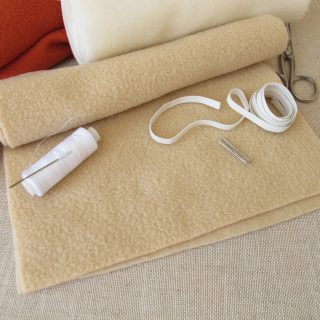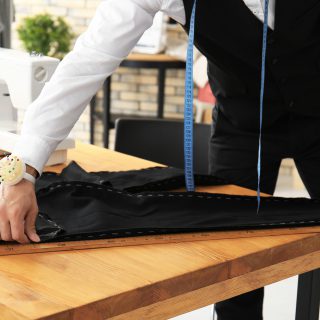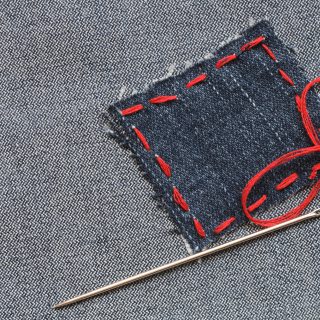Handmade tassels are a fantastic way to add a tasteful dose of boho charm to your home. These popular ornaments can liven up just about any space—your living room, bedroom, bathroom, and even your hallway. Don’t stop at putting tassels on your curtains—think outside the box and hang some on your bed posts, tie a few to a lamp, a shade pull, or a decanter, attach some to a garland, or create a colorful tassel door knob hanger. If your personal style is playful and bold, you can add a few tassels to the zips of your clutches or your keyring, too. The possibilities are practically endless!
Now that you know how versatile decorative tassels are, it’s time to learn how to make some in the comfort of your own home. Read on to familiarize yourself with the two most commonly used methods and the steps they involve. I’ve also included a short step-by-step guide on how to make leather tassels at the end of this post. Let’s get started!
Method #1: How to Make Tassels Out of Yarn
First, you need to get your hands on a few skeins of quality yarn in the colors you want to work with. You can choose wool, cotton, linen, rayon, silk, nylon, polyester, acrylic, or any other yarn fiber type. If your goal is to create smooth and shiny tassels, you should definitely go with cotton or linen.
Aside from yarn, you’ll also need a piece of heavy cardboard, a measuring tape or a ruler, scissors, a large tapestry needle, and a sparkly thread. The last item is for those of you who want to make sophisticated and luxurious tassels that can complement your home decor or personal style. In case reusing is your thing, you can cut up a cereal box instead of buying a brand new sheet of cardboard.
Once you gather these supplies, you’ll be ready to start the project. These are the steps you need to follow:
Step 1: Cut the Cardboard
Begin this step by determining how big you would like your tassels to be. The size you decide on will help you cut a cardboard template. A good rule of thumb is to make the piece of cardboard 2 inches wide and half an inch longer than the length of your tassels. The extra half will allow you to trim the ends without worrying about cutting them too short.
So, for example, if you want to make 3-inch-long tassels, your cardboard template should be 2 inches by 3½ inches (width and length respectively).
Let me remind you that the cardboard you use needs to be thick and sturdy to endure the wrapping part of the process.
Step 2: Wrap the Yarn
Wrap the yarn around the piece of cardboard starting at one end. Do it from the one long end to the other long end as many times as you need to reach the desired thickness. Generally speaking, you need to wind around 40 times for a standard-sized tassel, 20-30 times for a small tassel, and up to 70 times for a large tassel. However, this number can vary depending on your yarn’s thickness. Remember to take into account both sides of the yarn when deciding when it’s time to stop.
Pull the yarn gently to avoid bending the cardboard and ending up with shorter-than-projected tassels.
Step 3: Cut the Yarn
Once your tassel is as thick as planned, stop wrapping at the same end you started and cut the yarn in line with the bottom of the cardboard. This is to prevent that one thread from being shorter than the rest of the tassel.
Step 4: Create a Loop and Knot the Top
Cut a 15-inch-long piece of thread and double it over so its ends meet. Then, tie a knot around 1 or 1½ inches from the bend. Since you’ll tie the loop at the top of your tassel and use it to attach the tassel to whatever item you want to decorate, you can make it a bit longer if you think it’s necessary.
Next, wrap the looped piece around the middle of the yarn using the loose ends of the thread to tie a knot underneath. Make sure the loop is facing upwards and the loose ends become part of the tassel body.
Step 5: Remove the Cardboard and Cut the Bottom
Once the loop is tied securely, you’ll need to remove the cardboard piece carefully and cut all the threads at the bottom end of the cardboard (you only cut the end of the skein in step 3).
Step 6: Create the Tassel Head
To make the head, you’ll need to cut a 10-inch-long piece of yarn and tie it securely around the tassel body so it doesn’t slip. What size should the head be? It’s entirely up to you, but be careful not to make it too big.
Step 7: Hide the Loose Ends
Congrats, you’ve made it to the final two steps! Decorative tassels, just like any other ornament, need to look neat. That’s exactly why you need to hide the loose ends by threading them onto a large needle and pulling them through the tassel head. Cutting them is a really bad idea because the head might unravel, in which case you’ll have to do step 6 all over again.
Step 8: Trim the Ends
Finally, trim the yarn ends and straighten the threads if needed. That’s it—you did it!
Method #2: How to Make Tassels Out of Embroidery Thread
Embroidery floss is an excellent choice for tassels for jewelry and bag zips. This method consists of fewer steps than the first one, so if you want to complete the project quickly, this is the way to go. Be sure the number of skeins of embroidery thread equals the number of tassels you want to make as you’ll use one piece per tassel. You’ll also need an embroidery needle.
Step 1: Tie the Center of the Skein
Without removing the paper on the ends of the embroidery floss, carefully pull and cut off two 10-inch-long pieces of thread. Wrap one around the middle of the skein and tie it securely (you can fold the skein in half to determine its center and then spread it out again). If you want a loop, double one of the 10-inch-long threads, tie a knot around ¾ of an inch from the bend, and then use it to tie the center of the skein with the loop at the top.
Step 2: Fold the Embroidery Floss in Half
Now it’s time to remove the paper from both ends of the skein and fold it in half. Tuck the ties inside if you’ve decided not to have a loop.
Step 3: Create the Tassel Head
Use the second 10-inch-long piece of thread to create the tassel head. Simply wrap it around the tassel body around ½ or ¾ of an inch from the top and tie it securely.
Step 4: Trim the Bottom and Hide the Loose Ends
Snip the bottom of the tassel, work the loose threads into the body using an embroidery needle, and witness the ‘birth’ of a beautiful silky tassel.
Bonus Method: How to Make (Faux) Leather Tassels
Making your own (faux) leather tassels is surprisingly easy and affordable. To execute this project successfully, you’ll need:
- Natural or vegan leather;
- Key ring;
- Pencil;
- Scissors;
- Low-temperature hot glue gun;
- Rotary ruler;
- Cutting mat; and
- Rotary cutter.
Once you have all the materials and tools at hand, cut a piece of leather with dimensions 4.5 inches and 7 inches. Then, use the pencil to draw a horizontal line on the back of the leather 1 inch down from the top. The next thing you need to do is fringe the leather beginning at the line using the rotary ruler, cutter, and mat. Make sure the distance between each pair of neighboring fringes is around ¼ of an inch.
Cutting a long, ¼-inch-wide strip of leather, making a loop, and glueing the ends is the next step you need to take. Once you complete this, glue the end of the loop to the edge of the fringe and then glue the fringe around the loop. You’ll need a second long strip of leather, this time a 1-inch wide one, to wrap around and glue to the top of the fringe leather (this is, in a way, the tassel head). Choose a different color for this piece to make the tassel more fun and aesthetically pleasing. Finally, slip the loop through the key ring and attach the gorgeous ornament to whatever item you want to embellish.
Wrapping Things Up
Learning how to make tassels can help you undertake more complex projects, like sewing cozy tassel blankets and throws, stylish tassel pillow covers, and bold bathroom curtains with tassels. Try your hand at one of the methods outlined above and enjoy every second of the process!







